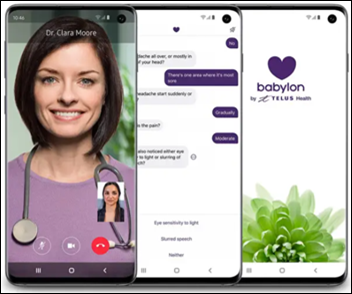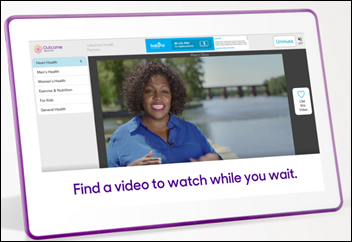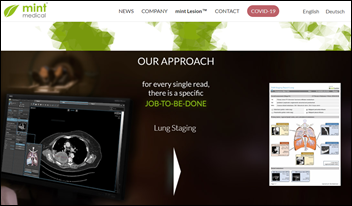Top News

Former Practice Fusion Director of National Accounts Steven Mack pleads guilty to attempting to obstruct the federal investigation into the relationship between Practice Fusion and Purdue Pharma after admitting he deleted hundreds of relevant computer files from his work-issued laptop.
Practice Fusion paid a $145 million settlement in January 2020 to resolve federal allegations that it violated the False Claims Act by configuring its EHR software to influence the prescribing practices of its end users for the benefit of opioid manufacturers like Purdue.
HIStalk Announcements and Requests

Welcome to new HIStalk Platinum Sponsor GetWellNetwork. The Bethesda, MD-based company’s interactive solutions engage patients and families, empower clinicians, and deliver outcomes that matter. It has been helping to unite providers and patients as partners in the healthcare journey for 20 years. From inpatient to outpatient, its comprehensive cross-continuum platform bridges care settings to create a seamless experience for patients and their families. Recent big news for the company was its acquisition of Docent Health, which offers AI-enabled outreach technology for consumer engagement and “next best step” in their care across episodes. Thanks to GetWellNetwork for supporting HIStalk.
I took a look at the technology being touted by some of the insurance companies and for-profit primary care chains that claim that their “full tech stack” differentiates them from stodgier but infinitely larger and more profitable competitors. That seems to be especially common in companies that offer Medicare Advantage plans. Consumer-facing apps usually had some combination of these capabilities:
- Appointment scheduling.
- Messaging, either directly with clinicians or with a “concierge team.”
- Telehealth visits.
- Plan details and benefits management.
- Status of claims, payments, prescriptions, and lab results.
- Doctor and urgent care finder.
- Cost comparisons, either drug or procedure.
- Smart watch or fitness tracker connectivity for health prompts, activity goals, synchronization.
- Prescription renewal requests.
- Home prescription delivery.
- Lifestyle assessment (sleep, diet, stress, exercise).
- Alerts and reminders.
- Collaborative sharing of EHR data and clinician notes (this was one specific national primary care practice).
These services alone don’t offer much competitive advantage since they are commonly offered. I expect that back-end systems contribute more to how companies market themselves, upsell to members, and create efficiency that may or may not translate into efficiency that can boost margins, so these seem a lot more important. Some of those I thought of:
- Anything that can help an insurer get to the scale needed to reduce per-member costs, improve provider negotiating position, and improve actuarial forecasts. Predicting and controlling costs is the bread and butter of insurance companies, which are not, despite their self-assigned labels, technology firms.
- Sales tools, especially for insurers and their broker network.
- Automated onboarding systems.
- Any kind of self-service capabilities that can reduce administrative costs.
- Enrollment for clinical trials, selling data to drug companies.
- Supporting paperless communications.
- Efficiently serving employers, who are the actual customer for most US-sold health insurance.
- Analytics to nudge members into behaviors that reduce short- or medium-term costs (companies aren’t likely to worry about long-term costs since members come and go and these public traded companies worry quarter to quarter).
- Customer relationship management to help overcome impersonal relationships at scale and to sell additional services, either those offered by the company or co-marketed through a third party.
- Chatbots to support members with administrative needs at scale.
- Patient education.
- Chronic condition monitoring and at-home monitoring to reduce the need for provider services.
- Customer segmentation and analytics to support variable pricing.
- Tools for clinicians to help ensure evidence-based practice, reduce documentation burden, increase payment efficiency.
- Fraud detection.
- Trying to integrate the web of third-party services that is the US healthcare system (labs, specialists, out-of-network providers, pharmacies, medical devices, home care, etc.) to provide a single experience that customers value.
My admittedly superficial conclusion is that most of the consumer-facing technology that insurers are rolling out is limited, focusing mostly on administrative tasks, upselling and cross-selling, and giving customers an alternative to long phone wait times for questions or complaints. A significant reason for this limited technology arsenal is that pure insurers have a mostly intrusive administrative role between the provider and the patient. It’s a different and much more interesting story when the insurer has vertically integrated itself to offer its own services in competing with providers who accept its insurance (as in the Kaiser Permanente model).
For me, then, companies that have a small insurance footprint (in terms of enrollees, markets served, revenue, etc.) seem to be highly at risk to big competitors who can outspend them, replicate their innovative tech tools, and just buy those companies if they get too sassy. US healthcare is almost always dominated by big companies that kept getting bigger, and late starters who hope that tech-powered disruption can upend the market (whether the insurance market or the stock market) may find that to be harder than it sounds.
Webinars
None scheduled soon. Previous webinars are on our YouTube channel. Contact Lorre to present your own.
Acquisitions, Funding, Business, and Stock

Canadian telecommunications company Telus will acquire Babylon Health’s Canadian operations. The deal includes a $70 million licensing fee for virtual care technology already used by Canadians in the Babylon by Telus Health app. Babylon Health is reportedly exploring IPO options via merger with an SPAC.

Patient payment vendor Cedar raises $200 million in a Series D investment round led by Tiger Global Management, giving it a $3.2 billion valuation.
Rural hospital operator Rennova Health cancels plans to sell its software and genetic testing interpretation divisions to InnovaQor, which would also include telehealth technology that Rennova had licensed from TPT Global Tech. Rennova says the companies could not agree on terms, but it will still pursue separating its software assets.
AI-powered cancer pathology diagnostics vendor Ibex Medical Analytics raises $38 million in a Series B funding round, increasing its total to $52 million.
Sales
- USA Health (AL) selects Twistle’s COVID-19 vaccine management technology, including automated patient outreach and adverse effect reporting.
- Wellstar Health System (GA) will offer its employees digital health and wellness resources from Sharecare, and will work with the Atlanta-based company to develop similar tools for patients.
- Hartford HealthCare (CT) will implement Cedar’s patient billing software.
- The Christ Hospital Health Network (OH) selects Omnicell’s automated Central Pharmacy Dispensing Service.
- Mountain Health Network (WV) will work with Infor, The Chartis Group, and Avaap to implement Infor’s CloudSuite ERP technology.
People

Kevin Johnson, MD, MS (Vanderbilt University Medical Center) joins University of Pennsylvania as professor, VP of applied informatics at University of Pennsylvania Health System, director of a new informatics center, and senior scientist in science communication.

Southwestern Health Resources hires Donghui Wu, PhD, MBA (Texas Health Resources) as VP of data science and analytics officer.


Investor and advisor Scott Vertrees joins Heal as CEO, replacing co-founder Nick Desai, who remains a shareholder.

H1 names Julie Stern (HealthReveal) CISO and VP of engineering.

Alcatel-Lucent Enterprise promotes Lisa Simpson to head of North American sales.

Provider analytics vendor Trilliant Health hires Sanjula Jain, PhD (The Health Management Academy) as SVP of market strategy / chief research officer.
Announcements and Implementations
Fifteen VA health systems and medical centers in 11 states join Medicom’s health information network.

Change Healthcare announces GA of Data Science as a Service, which assists customers in using de-identified claims and social determinants of health data for analytics projects.

Philips will add OpenDoctor’s radiology patient self-scheduling technology to its new Patient Management Solution of its Radiology Workflow Suite. The system will also offer contactless registration, automated communication, and intake questionnaires.
Meditech launches a genomics solution for its Expanse EHR, which includes the ability to collect and store patient genetic information, connect to reference labs, and enable personalized treatment. Its embedded pharmacogenomic alerts are provided by First Databank.
PVerify launches a real-time and batch Medicare Beneficiary Identifier lookup solution that can be accessed via API, Excel file batch processing, or individual patient lookup on the company’s portal.
COVID-19
CDC says it’s OK for people who have been fully vaccinated against COVID-19 to gather indoors without masks and distancing, as long as the group is made up of either all people who have been fully vaccinated or those from the same household who are not at increased risk. Masks and distancing are still recommended while in public, while visiting with unvaccinated people who are at increased risk, or when assembling in groups that involve multiple households. Domestic and international travel are still not recommended, advice that CDC defends by citing a lack of information about the impact of variants.
A study finds that the relationship between obesity and negative COVID-19 outcomes is nearly linear, as increased BMI is associated with higher rates of hospitalization and death. Severely obese patients were 33% more likely to be hospitalized and 61% more likely to die of COVID-19 than non-obese people.
A study that was performed using University of California EHR data finds that 27% of people who tested positive for COVID-19 experienced symptoms that lasted 60 or more days afterward, including shortness of breath, chest pain, cough, or abdominal pain. Many of those people did not originally experience any symptoms when they tested positive, and the severity of any initial symptoms didn’t always line up with eventual post-COVID problems. Patients in all age groups had long COVID effects, including 11 of the 34 children in the study. The study was limited in that (a) it was not able to review people who were asymptomatic but didn’t get tested; and (b) the static 60-day snapshot would have missed an unknown of people who don’t develop problems until after two months.
Other

A long-time hospital IT technologist friend of HIStalk and supporter of my Donors Choose projects sent a CIO job opening my way for Denver Health. You can read all about its clinical and community services (the latter are extensive), and on the IT side, Denver Health is in the 91st percentile of Epic’s gold stars program and recently migrated its self-hosted data centers to colocation centers (the new CIO will lead development of a full-blown cloud strategy). US News & World Report ranks Denver and nearby Colorado cities as four of the best five places to live in the US (Boulder, Denver, Colorado Springs, and Fort Collins). What better candidate can you get, my reader asks, than someone who routinely reads HIStalk? I appreciated that thought so much that I decided to mention the job opening here, which I usually wouldn’t do.
University of Washington researchers develop an Alexa skill that can detect heart rhythm problems in people who sit within two feet of a smart speaker during a telehealth visit. They are also looking at whether the same technology could detect sleep apnea in the home.
Sponsor Updates

- Clinical Architecture staff volunteer at the Gleaners Food Bank of Indiana.
- Capsule receives the 2021 New Product Innovation Award in the North American remote ventilator surveillance industry.
- Humber River Hospital in Canada deploys Ascom’s transformative tech ecosystem for improved patient safety.
- CarePort announces that more than 130 hospitals and health systems selected CarePort Care Management in 2020.
- CereCore publishes an overview of Meditech reporting and regulatory submission.
- The Cerner Charitable Foundation approves medical grants for 66 children.
- SOC Telemed earns full URAC accreditation in telemedicine.
- Frost & Sullivan features Change Healthcare in its Executive Brief, “Empowering Healthcare with a Cloud-based Enterprise Imaging Strategy.”
- ChartSpan will market its services to members of the Kentucky Hospital Association.
- Clinical Computer Systems, developer of the Obix Perinatal Data System, releases a new Clinical Concepts in Obstetrics podcast, “Cardiac Disease in Pregnancy.”
- Divurgent releases a new episode of The Vurge podcast, “Using AI to Identify and Correct Issues with Claims.”
- Waystar adds text statements to its line of payment tools, and announces that nearly 300 healthcare facilities now use its Price Transparency solution.
Blog Posts
Contacts
Mr. H, Lorre, Jenn, Dr. Jayne.
Get HIStalk updates.
Send news or rumors.
Contact us.
























































Anything related to defense will need to go to Genesis.